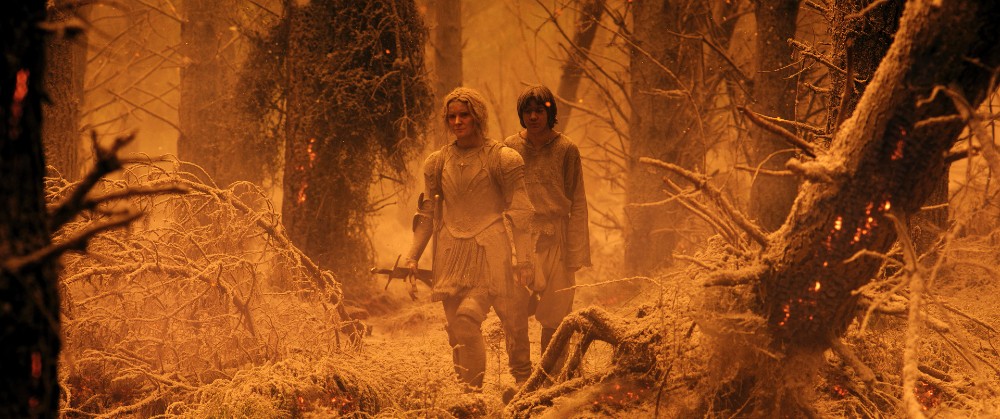
Prime Video’s new big-budget series The Lord of the Rings: The Rings of Power offers fans of J.R.R. Tolkien‘s masterpiece another chance to see Middle Earth brought to life — this time, hundreds of years before the events depicted in the six Tolkien movies made by Peter Jackson.
The work of Production Designer Ramsey Avery is featured front-and-center on the hit Amazon series, which spared no expense. Avery was ready for the opportunity, having spent many years working in the art department of numerous films before getting the call to bring Tolkien’s worlds to life in Rings of Power.
Below the Line recently spoke to Avery about his inspirations for the intricate layers of design work required for Rings of Power, as well as the amazing art and set decoration team he worked with on the show.
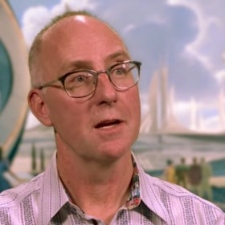
Below the Line: Rings of Power is a great showcase for your work and that of your entire art team, seeing as it’s on display in every frame.
Ramsey Avery: That’s one of the things I really liked about how they’ve shot and edited this one — they really let the world breathe. You really do get a chance to see the world, all the way from [wide shots] to extreme close-ups. It’s not just standard television, where it’s mostly just headshots.
BTL: I looked over your filmography and the work you’ve done before. Did you have a connection on the show or did you have to do a big pitch to get the gig?
Avery: It was slightly interesting. I know Lindsey Weber from work on several Bad Robot projects. I was a Supervising Art Director on Star Trek, and then I designed 10 Cloverfield Lane, [on which] she was executive producer on that, so I knew her. The funny thing is I actually had reached out to her, because my husband does theme park design, and I was curious whether or not Amazon had any theme park design division going on. So I reached out to Lindsay to see if she knew of anything, and she said, ‘No, I don’t know. But what are you doing?’ So it just happened to be one of those right calls at the right time kind of moments.
BTL: Where do you begin with a show like this? Obviously, there had been six other Tolkien movies directed by Peter Jackson, as well as thousands of additional words written by Tolkien himself. Do you go to the books first and ignore the previous movies? Tell me about your process.
Avery: Part of what happened is that I came in kind of halfway through prep and had to kind of take over and rejigger and redirect the project, design-wise. There were some things already in place. One thing that was in place that was great was that Kate Hawley — she’s the Costume Designer — had done a series of mood boards for each of the cultures, [which] the showrunners really liked.
So there was a basis in there, in terms of a tonality for each of the races, and then the showrunners gave me a series of parameters, which were generally 1.) It has to be real, both in terms of, we want the sets to be real, as much as we possibly can, rather than blue screen/green screen environments, and we want to feel like people really live in these worlds. We don’t want high fantasy. We want it to feel like they are actual, honest places where people can live.
[Second,] they wanted to be really clear [about] how each of the environments had its own kind of signposting in terms of shapes and volumes and colors, which isn’t something that was really clear in Kate’s boards because Kate’s boards are about costume and textures, so there was a thematic characteristic to them, but it wasn’t about really creating a tonality of the world.
And then, the third thing they said is that it has to be true to the books, so it’s always going back to the words. I’m a deep fan of Tolkien. I have been since I was 10. Back in the ’70s, I read everything that was possibly available at that time. One of the things I did is I started rereading The Silmarillion on a fairly regular basis just to get the tone and some of that deep history into my head.
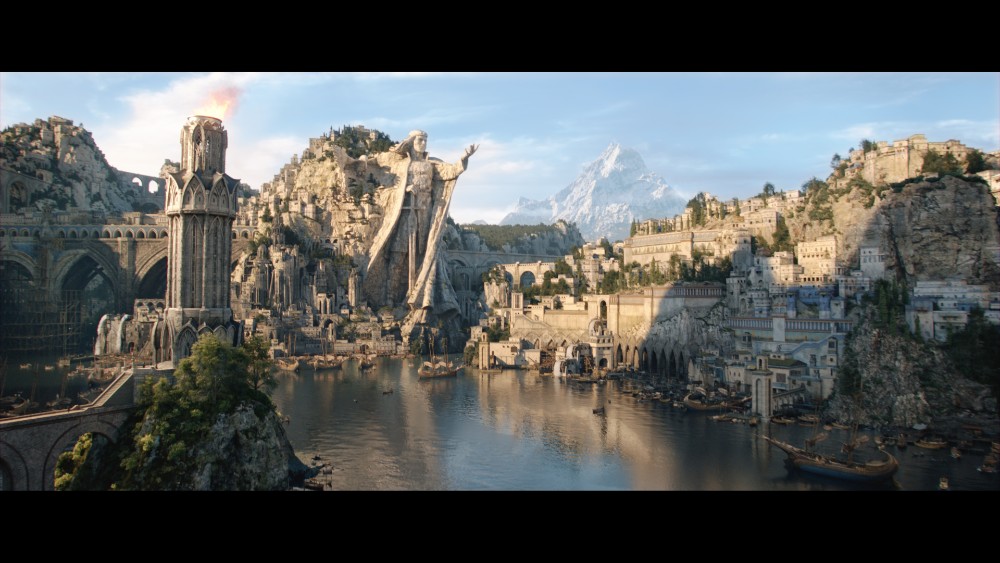
And then, the last thing is that there are the movies, so that we, the audience, have an expectation of what the movies are bringing to the world and how they represent Middle Earth. But that’s 3000 years in our future, and it represents decay and decline, and our world is about the vibrancy and the grandeur of all of these races, as opposed to what we see later on.
Those were the signposts of the box that we were working ourselves into, and then, from that, I basically went into each of the cultures, and I started to see where are the characteristics in our history, in our world, [and there] things that we would recognize and have some resonance to that helped fit into each of the different cultures, whether it’s looking at the idea for the elves, looking into both kind of romantic artists, and the sense of how that ties into an arts and crafts kind of sensibility, but also looking into ancient Celtic styles [and] La Tène styles so that you get a much more ancient feeling underneath of all of that. And then looking at high-resolution close-up photography of plants. Basically, what we started to do was think about each race [in terms of,] ‘what is the characteristic that defines each race?’
Elves, in Tolkien, come from nature. They were first brought forth in the forests under the stars, and they lived there for a very long time before they started moving west. The sense of elves being of nature, and how would they then start to define architecture through that love of nature, which led to the idea of exploring plants, and the organic forms of Celtic ornament, and contrasting that with the dwarves, who are of stone and fire. [They] have this whole history where they were created by their god independently of the other races, and what that [means] in terms of making them interested in making and creating in the stone and the fire. Looking at ancient salt mines and ancient Eastern European stone carving, and digging into that type of form language, and contrasting that with the Númenóreans, who Tolkien at one point said that he had just gotten back from Númenór — “Oh, I mean, Venice” — so there was this sense in his head that we could interpret that there was a sense of history and opulence and grandeur. But then, in our world, looking [at] how to make that feel more ancient and looking to ancient Babylonian or Minoan styles, and then kind of dialing that up into Roman.
In all of those cases, saying where they fit tonally with all the artwork that’s been done over the last gazillion years, in terms of Tolkien artwork. When I was a kid, it was the Brothers Hildebrand — that’s what Tolkien looked like. Then there was a Ted Nasmith period, and then there were some weird periods in between that Roger Dean came in there for a little bit, and then it kind of moved into the Allan Lee and John Howe world. Trying to find the sense of epic, and the sense of line, and looking back at Tolkien’s drawings, which are very graphic and very precise of his world, and seeing what the throughline [of] all of that is, [which] leads us to the Peter Jackson movies, and finding the bits and pieces out of all of that.
There’s form language from the Peter Jackson movies that I could pull from, but there [are] also things I wanted to respond against. An example being when we see Moria in Fellowship, it’s when it’s been destroyed, and the whole reason it’s been destroyed is because the dwarves — the line is, “They dug too deeply and too greedily.” That represented, to me, looking at that architecture, which is super-monumental and huge, and it’s really kind of forced the dwarves intentionality on the stone, kind of disrespecting the stone, and thinking about what Gimli says in the Two Towers when he’s describing the Glittering Caves.
There’s a whole description about how sometimes dwarves will only do one ship in a day when they find something they really love, and thinking about then, ‘how would we differentiate how our dwarves looked versus the dwarves who dug too deeply and too greedily?’ Ours are much more respectful of the stone, so you’re always seeing the stone in our Dwarven architecture. You see the veins, you see the natural stonework, [and] the art of the carving comes out of that. It was always that kind of play back and forth, talking with the directors and the showrunners and seeing what parts and pieces they liked, to find that vocabulary, [and] at the same time, working with all these races and all these beings. It was a deep dive, straight-in.
BTL: That’s a lot of stuff to draw from for research. How much time did you have between signing on and them having to start shooting?
Avery: In this case, what happened is that I came in halfway through prep, so I literally got parachuted into the middle of it and had to do a quick sort through what was working and what wasn’t. Most of it wasn’t working — that’s why I was brought in, to make it work — and finding the parts and pieces and then just really concentrating on what was gonna go in front of the camera first.
I knew that the village had to go first and the elves had to go first, and the Harfoots had to go first, so picking those three environments, and really concentrating and triaging them, and then knowing that the dwarves came next, and then Númenóreans came after that. In the middle of that, I actually had to do orcs. One of the very first things we had to do was the Northern Wastes and Forodwaith and all of that. Really, trying to take the firehose of visual information, and then distribute it out to a really wonderful team of concept artists and art directors, and set designers.
At the highest point, we had 30 illustrators working at the same time, and they were working literally across the world. It was five different continents [and] nine different time zones. Literally, the sun never set on the Rings of Power art department. There was always somebody, somewhere in the world, working. That meant that I’m up at five o’clock in the morning talking to LA and working my day through the time zones, through New Zealand and Australia, and then over to England at the end of the day when they were actually starting their next morning, right? My whole day was a series of trying to communicate with people across the entire world.
BTL: Did you actually start this before the pandemic?
Avery: I started at the end of summer/early fall of 2019, and we actually filmed for a couple of weeks of Episode 1 before the pandemic hit. We started filming the village and started filming a bit of the Northern Wastes stuff before we got shut down. Basically, what happened is they sent all of us to our various corners [of] the world, and we kept working. There was so much to do that we just kept designing, designing, designing, talking, talking, talking. Because New Zealand got everything under control pretty well, we were able to get back into the country in a couple of months and start building again. We were able to keep moving forward pretty efficiently.
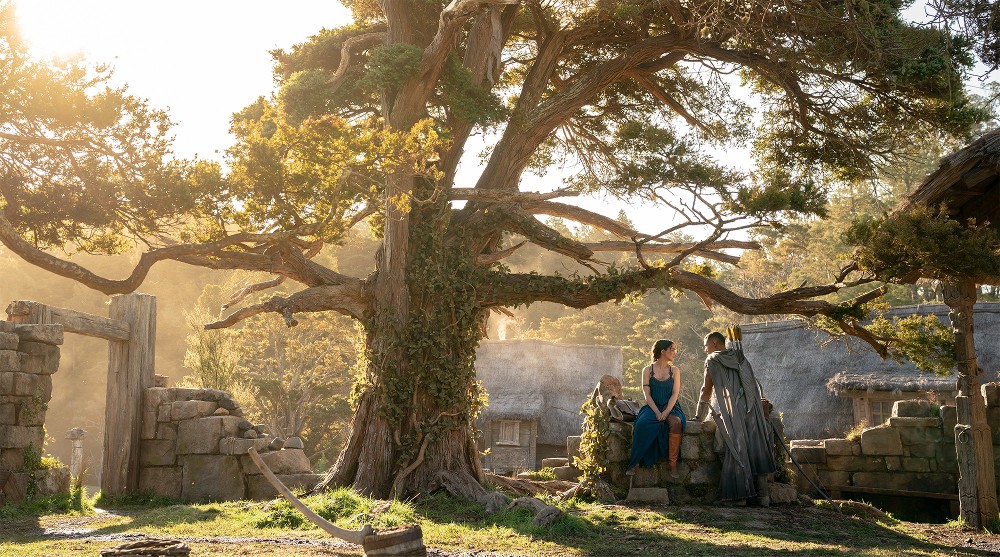
BTL: You mentioned there were certain places where the story begins in the first two episodes, but then it turns into a journey with a lot more places. When do you start building for Episode 3 with the director who takes over from J.A. Bayona?
Avery: One of the things that J.A. did that was really great, [and] it was kind of terrifying when he first brought it up, but he wanted to have at least one piece of key art for every single scene in the first two episodes. That’s a tremendous amount of art, but what that allowed us to do was to get very specific about, ‘what’s the lighting, where’s the camera pointing? What is the form language? Where do we move from point A to point B within the scene?’ Working all that out with him allowed us to get a really good handle on what the nature of the project was. It gave us a good basis.
One of the things that was interesting about working in New Zealand is that when you step off the stages and you go into location, you’ve got very strong governmental agencies you have to work with. You’ve got what are called councils, and basically, every bit of land is overseen by a council. Sometimes, you also have federal department of conservation areas to work on, and you also have Maori, the indigenous, and the Iwis, the tribes, so sometimes you’re dealing with that as well.
There’s a lot of time invested when you go off the stages in terms of how you’re going to maneuver a piece. Or village, for example, the location was chosen when I started, but the village itself wasn’t worked out yet. What we had to do was very quickly resolve the number of buildings and how we’re building them, what the structure was of them, to get that in front of the councils, so we could get approvals to get building. Part of the secrecy of what we were doing is, we couldn’t actually tell them everything, we were doing, but we could give them very simple shapes to understand the level of construction we were doing. We would actually end up drawing things multiple times for multiple different approvals, but it really was just sitting down with Jules Cook, the supervising art director. We brought in another supervising art director, Don Macauley from Vancouver to come in. What Don did was he sat down and worked through all of that scheduling issues to figure out what we had to concentrate on first, and how to adjust the budget to fit into all of that, while Jules was working with the very specific sets that we had to start moving on — the ice wall, and the village — those things that involved super-complicated either stunts or super-complicated involvement with the local councils that just had a very long lead time.
BTL: I assume when you came on board, they didn’t have all eight scripts completed for you or did they?
Avery: No, in fact, one of the things that was interesting is that when I came on board, there were 10 episodes, and right before I came on board is when Amazon decided to rework it down into eight episodes. That was part of what was going on as well — all 10 episodes had to be rewritten down into eight and things had to be jettisoned and things had to be reworked and reconfigured. We were like a normal television show or a normal tentpole movie — we didn’t know what Act 3 was until not too long ahead of when we were shooting Act 3.
BTL: Did you at least have some idea when locations might have to return for some of the later episodes?
Avery: There was an outline that gave us the signposting throughout the entire season, for sure. We knew the weight of where we had to concentrate. One of the issues with our production, in regards to the whole financial thing about the “most money ever spent for a television show” and all of that, in my world, looking at what I had to deal with, it wasn’t significantly more than budgets I’ve been able to work with on some of the tentpole movies like Guardians of the Galaxy Vol. 2 or Star Trek.
In terms of the actual spend for the scenery, it wasn’t that grand, the difference being that that’s for two and a half hours of scenery versus eight hours of scenery that we had to do for the series. What that kind of translated into is that it’s very expensive, as you may know, to pick up a crew and go on location. Even though we were in New Zealand, with the most spectacular locations in the world, and they all look like Middle Earth, we couldn’t actually travel to a lot of those. One of the things we had to start to figure out very quickly was, ‘where are we going to concentrate our location spend? What did we really have to go do outside someplace?’
One of the very first things I did the first month I was there — in addition to trying to organize all this artwork — was get on a helicopter and an airplane and go look at the entire two islands of New Zealand to figure out what was there, so we could start that conversation of where we were going to put our emphasis and where we were going to go on location.
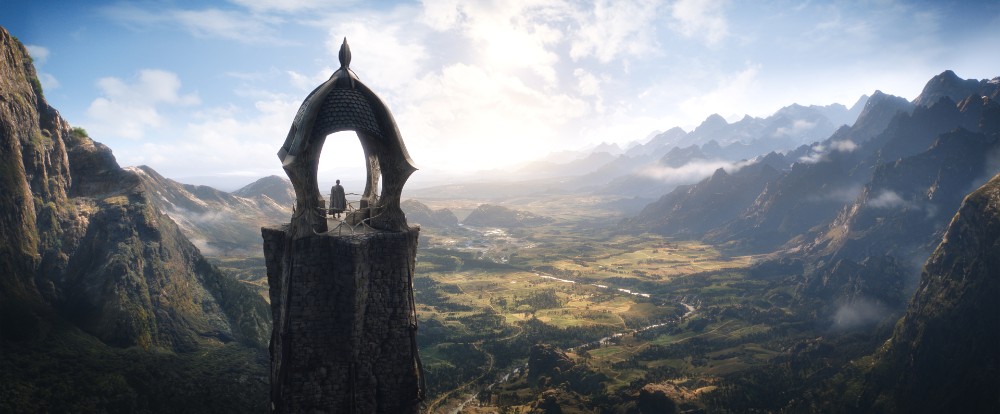
BTL: How many soundstages did you have going at the studio where you were doing that work?
Avery: We were at three different studios. There was Auckland Film Studios, where we had three stages, one fairly good-sized stage, and two small stages. Then we were at Kumeu, where we had, like, regular Hollywood sound stages, and then we had a warehouse space and a backlot there as well, where we built all the exteriors of Khazad-dûm and the exteriors of Númenór were built there. And then, further away from town, there was an old horse training rink. What was great about that is it had a dirt floor, so we [could] actually dig down into the floor and give ourselves topography in there. It had a couple of parking pads on the outside, so we had that stage and then we ended up using one of the pads on the outside. Our Ostirith was built on one of those pads, and then we had the horse arena “stage” there as well, so we had seven stages and a couple backlot pads to work on.
BTL: I think the first two episodes were directed by J.A. Bayona, and then the other two directors were also DPs doing the other six episodes, right?
Avery: Wayne Yip was [the] director and co-executive producer, and his DP was Aaron Morton, and then the third director was Charlotte Brändström, who had her DP, Alex Disenhof. Wayne was really instrumental, [as] he and I were the ones who worked through all of Númenor and then kind of got our spots together and took it to the showrunners to get it worked out that way. Charlotte ended up doing most of the big action sequences in Episodes 6 and 7, so she was mostly in the Southland. She didn’t have a lot to do with Númenor or some of the other… she had a little bit to do with the Harfoots, but mostly, she had to do with the Southlander story.
BTL: I am curious about the set decoration, because there are many locations and characters who we learn more about based on what they have in their homes and such.
Avery: That’s a great question because this project only lived and breathed because there were other hard-working, heartful, passionate people in all of the other departments. We had two set decorators, one who was a local, Megan [Vertelle], and then we had an American come in to help because it was just huge. But he had to leave after COVID started — he couldn’t come back — so we brought in a Canadian, and then he had to leave.
So Megan got to kind of really do the show mostly on her own, and she had a very strong group of artists and artisans. She had great painters and great sculptors, and she had the most amazing soft goods team, the two women who did everything from hand weaving, all of those fabrics that went on the Harfoot covers. If they looked natural and handmade, they really are natural and handmade, and they had a weaver who did all the willow-weaving to make those cards, [so] it was all done by hand.
The soft goods [people] also did the beautiful tapestries, from the one that’s at the beginning of Episode 1 with the trip to the Undying Lands, the tapestry that goes behind the king’s bed, which is 25 feet tall, and the curtains and the drapes and the bedding. There were a couple of people who were absolute magicians and the soft goods people were one, and Simon Lowe, the guy who did all the greens work. He could make a sheep paddock outside of Auckland look like an Elven forest in an amazing amount of time. Just super great, talented people in all of those positions.
The prop master and his team were amazing. Weapons, the people making all the weapons down in Weta, and all of that communication of how to get all that working, and how that fit with costumes and stunts. All of that coordination all the time, it was a constant churn of information flow.
BTL: My last question was about the move to England for Season 2. Why was that decided?
Avery: When they pack up and move to England, part of it was a scheduling thing, and part of it was they just wanted to keep it with local talent. Initially, all the heads of departments were all UK-based, so that’s where we’ll do Season 2.
BTL: Great! I’m talking to VFX Supervisor Jason Smith soon so I’m sure he’ll have more to say about some of what we’ve discussed.
Avery: That’s the other component, of course, is that every bit of this is worked out. It’s a constant communication with everybody — showrunners, directors, DPS — but the thing that was most joined at the hip was visual effects. Even though we tried to put everything we possibly could in front of camera, you can’t put the whole world in front of camera, plus you have all those scale issues where you’ve got humans who are the same size playing against characters who are not supposed to be the same size. We had Harfoots that were six-foot-two, so trying to make them look small next to the Stranger, who’s also six-foot-two, we had to have all that work together, that constant communication with visual effects and Jason. Jason is amazing. He’s just an amazing human being, and he’s an amazing talent, and I had the best time working with him.
BTL: And as promised, here’s a breakdown of that Númenor harbor shot we mentioned earlier:
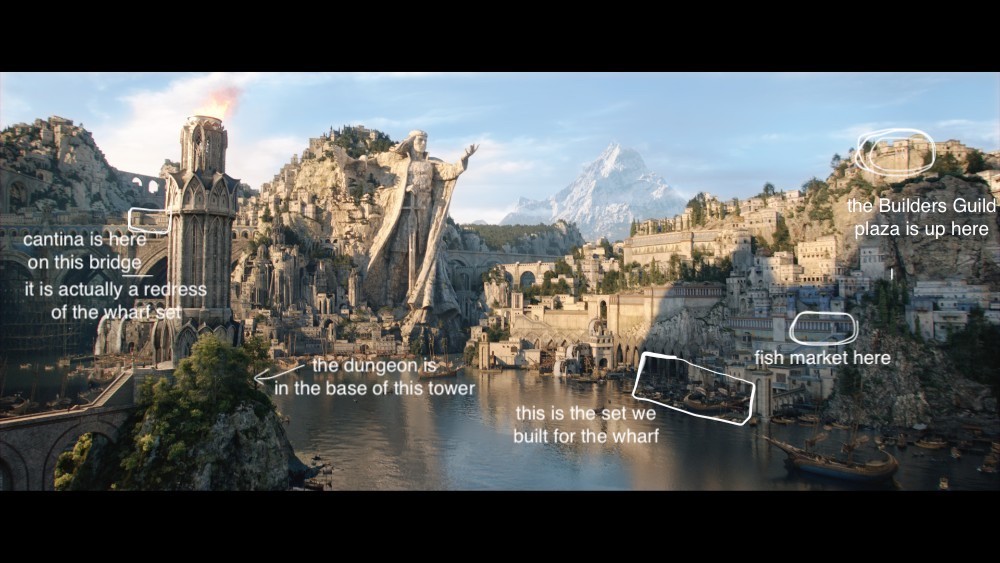
Avery: No real location, but built-up using elements of the Alderman and Mokohinau Islands off the east shore of the North Island, cliffs on the NW side of the South Island near Kahurangi National Park, and the gorges of the Rangitikei River in the southern part of the North Island. The original layout of the topography was worked out with Julien Gauthier at ILM and then blended with the set we built at Kumeu FIlm Studio, near Auckland.
The first seven episodes of Season 1 of The Lord of the Rings: The Rings of Power are now streaming on Prime Video. Watch the trailer below, and come back next week for an interview with the show’s VFX Supervisor, Jason Smith.





